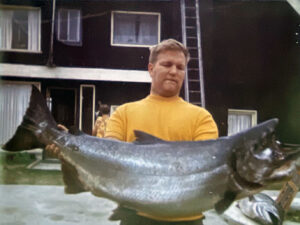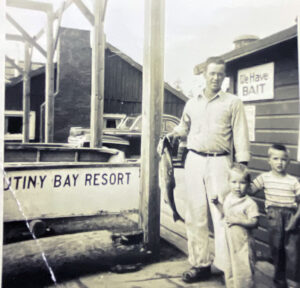THE DOCK AT MUTINY BAY RESORT
In the Spring of 1955, my father and mother, Howard and Millie Egerton, purchased Mutiny Bay Resort from Chet Holt. The Egerton’s owned and operated the Resort for about 20 years before selling it. The property had 300 feet of waterfront with a restaurant, two boat houses, about 20 fisherman cabins, a house we lived in and a storage building.
The beach had a wooden bulkhead which was located in front of the fisherman cabins on the north end of the beach. On the beach were some sand traps (pilings that had wooden planks to catch the sand). It was a nice, sandy beach from the north end of the property to the south end.
There was a small gauge iron track installed that originally came from an old mine. The track was located in front of the boat house and ran out about 100 feet into the water. We launched the sixteen-foot wooden plank fishing boats on that metal track for a few years. The contraption that was used to pull the boats in and out consisted of belts and pulleys. About once a day, we would apply rosin to the belts and pulleys so the belts would not start to slip.
We soon realized that we could come up with a better system for launching the boats. My father, Howard Egerton, installed some pilings in from the boat house for about 250 feet out to a shack on the beach which had a contraption that he made from a rear end of a car. It had belts running to an electric motor. It worked by pulling the boats past the shack and slinging them down a small hill we built. It was high enough that it had quite a slant and it ran down into the water. Gravity got the boats into the water.
Our most significant project was to build the Dock. By this time I was 20 years old, old enough to help my father with the building of the dock. I took two quarters off of college to help. My younger brother Gary who was 15 also helped. This was in 1962.
To do this, we used 20 foot creos ote pilings (originally made to be telephone poles) which had washed up onto the beach from a boom that had broken up in a storm. They were washed up all over the south end of the island.
ote pilings (originally made to be telephone poles) which had washed up onto the beach from a boom that had broken up in a storm. They were washed up all over the south end of the island.
 ote pilings (originally made to be telephone poles) which had washed up onto the beach from a boom that had broken up in a storm. They were washed up all over the south end of the island.
ote pilings (originally made to be telephone poles) which had washed up onto the beach from a boom that had broken up in a storm. They were washed up all over the south end of the island.We borrowed a half-track vehicle with wheels on the front and caterpillar tracks on the back. We installed an A Frame with a hand cranked winch on the front of the vehicle to pick up the creosote pilings and stood them on end.
We had a seven-horse Briggs & Stratton motor hooked to a pump so there was strong enough water pressure to sluice the sand out from under the pilings so they would sink down into the sand about 8 feet until they hit the hard pan. We put two rows of pilings from the shore to minus low tide area using this method.
We then decided to hire Mr. “Cat” Cattron from Langley. He used a pile driver to install the creosote pilings from the low tide area out to a total of about 250 feet. We had gathered enough pilings to complete the entire dock.
We found a huge log, (Douglas Fir) on the beach that had washed up south of the resort that was 3-feet in diameter by about 20 feet long. We pulled it in to the boat house with the boat launching cart.
We cut it up with a chainsaw into sections long enough to go between the pilings as stringers. In order to make it into 2 X 12 planks, we took it up to Lehman’s Sawmill near Freeland to have the planks made. The wood was so fine, there wasn’t a knot in it. It could have been used for “finished” lumber.
At the far end of the dock, we built a platform for a pump house. It was 12 feet x 12 feet. The actual pump house was 6 feet x 6 feet.
We built a four-foot wide ramp with chain link fence and wheels on the end of the ramp to roll up and down on the floats when the tide came in and out. The two floats were made from cedar logs and boards we had milled. Each float was about 30 feet long by 6 feet wide. We pulled the ramp up onto the dock in the winter and took the floats onto the beach.

We placed about eight buoys in the deep water in front of the resort for people to tie their boats up. They would then get back and forth to shore by using a small row boat which was on the floats. They would pick it up from the float, take it out with them to the buoy, tie their boats up to the buoy and then row in to the float.
The buoys were made out of old tires and beer kegs. Each buoy had a chain with swivels on each end. The anchor was made out of a block of cement which was about 3 feet x 3 feet. The anchor would dig into the sand and would hold very well.
Every Spring, we used a hand crank winch to lower the anchors down into the water and in the Fall we pulled them up with the same winch. We put the anchor into a 16 foot boat and stored the chain in a five gallon bucket. We put stove oil in the bucket to protect the chains from corrosion from the saltwater.
Other people who helped us with building the dock were Warren Burrier and Harry Josephson. They helped some with the pilings and nailing down some of the decking on the dock.
I think some of the original pilings that are there now are the same ones we installed in 1962. It is amazing to me that now when I look at maps of Mutiny Bay, the same dock we built for our little resort is now a landmark on all the maps!






